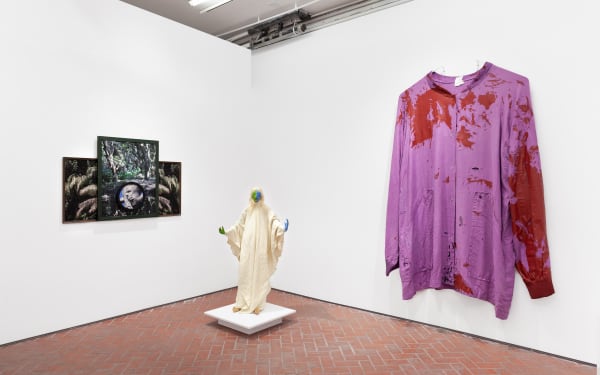Gallery hours by appointment: Tuesday - Saturday, 10:00 am - 6:00 pm
*Please note, the gallery will be open Saturday and Sunday, September 12 & 13 to mark the opening of this exhibition. Visitation is by appointment, scheduled in 30 minute increments for up to 4 people in the same party.
Shulamit Nazarian is pleased to present I am not this hair, I am not this skin, I am the soul that lives within., a group exhibition curated by Los Angeles-based artist Amir H. Fallah. Presented in the gallery's new project space, this exhibition features works by Daniel Gibson, Todd Gray, Amanda Ross-Ho, and Francis Upritchard. It will run concurrently with Fallah's solo exhibition Remember My Child...
Derived from a quote by the 13th-century Persian poet Rumi, the exhibition's title points to the exhibiting artist's vastly different use of imagery and materials to examine the nature of portraiture by moving beyond the physical representation of a particular subject. In dialogue with the themes of Fallah's solo exhibition, Remember My Child..., these artists explore what it means to make biographical work through symbols, archetypes, and surrogates, in an effort to challenge the nature of representation.
Growing up in the border town of El Centro, Los-Angeles based Daniel Gibson's paintings intermingle abstracted human figures, objects, and elements of nature to create dream-like narratives, using memories to explore themes of identity and migration. "Some of my first drawings were of the desert horizon with ocotillo plants and Mt. Signal. We used to watch people from Mexico trekking across the blazing hot desert, kids and families drinking from water jugs," states Gibson. Shifting between the genres of portraiture, landscape, and still life, Gibson's surrealistic scenes conjure people from his past as a way to further examine the present.
At once sculptural and photographic, the works of Los Angeles and Ghana-based Todd Gray offer complex representations of blackness, the African diaspora and the African landscape. Using the discursive qualities of archives, combined with the fragmenting qualities of assemblage, Gray finds new narratives through the act of cropping, combining, and reframing images. Juxtaposing photographs- landscape, architecture, decorative symbols-from Western European sites with similar imagery from locations in South Africa and Ghana, Gray reveals the often invisible aesthetics of colonialism. Focusing specifically on the relationship between the colonizer and the colonized, Gray investigates gaze through a medium that has historically been used for the categorization of bodies and nature.
Los Angeles-based Amanda Ross-Ho isolates artifacts and phenomena observed in the everyday that offer meaningful connectivity to a larger understanding of collective experience. Through reflexive and theatrical objects and installations, she builds poetic and inquisitive environments that trace imagination within the confinement of contemporary life. Untitled Smock (ACCIDENT) is a fastidious, large-scale translation of a studio smock that marks the spill of a gallon of red paint on the artist's working garment, creating a pseudo-violent gestural abstraction on its surface. Each detail-the splatter, the mangled label, the custom snaps-is forensically detailed and recreated, monumentalizing the intimate presence of trace and body.
London-based Francis Upritchard sculpts figures and objects out of everyday materials such as modeling clay, tinfoil, and wire. Looking towards historical artifacts, these sculptures appear museological, yet without time or place. The artist's alternative anthropology upends traditional methods of display by imbuing institutional structures with fantastical indexes and far-flung references. Using a philosophical reclamation and reuse of historical facts, myth, thrift shopping and garbage picking, the artist rewrites a personal narrative into a larger history of human archetypes.
Click here to learn more about the curator, Amir H. Fallah
-
 Daniel Gibson, A four week Alan Watts video loop, 2020
Daniel Gibson, A four week Alan Watts video loop, 2020 -
 Daniel GibsonCharcoal Body, 2020Oil on linen25 x 21 inches
Daniel GibsonCharcoal Body, 2020Oil on linen25 x 21 inches -
 Daniel GibsonEl Gulfo, 2020Oil on canvas, oil on artist frame24 x 31.75 inches
Daniel GibsonEl Gulfo, 2020Oil on canvas, oil on artist frame24 x 31.75 inches -
 Todd Gray, Sketch (Portrait Garden), 2020
Todd Gray, Sketch (Portrait Garden), 2020 -
 Todd Gray, Sketch (Smiling Faces), 2020
Todd Gray, Sketch (Smiling Faces), 2020 -
 Francis Upritchard, Vivian, 2017
Francis Upritchard, Vivian, 2017 -
 Francis Upritchard, AC Flash DC, 2013
Francis Upritchard, AC Flash DC, 2013 -
 Francis Upritchard, Grey Face and Sex Pot, 2018
Francis Upritchard, Grey Face and Sex Pot, 2018 -
 Francis Upritchard, Red Face Woman, 2018
Francis Upritchard, Red Face Woman, 2018














